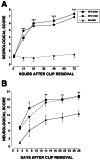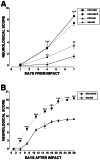Recombinant human erythropoietin counteracts secondary injury and markedly enhances neurological recovery from experimental spinal cord trauma
- PMID: 12082184
- PMCID: PMC123161
- DOI: 10.1073/pnas.142287899
Recombinant human erythropoietin counteracts secondary injury and markedly enhances neurological recovery from experimental spinal cord trauma
Abstract
Erythropoietin (EPO) functions as a tissue-protective cytokine in addition to its crucial hormonal role in red cell production. In the brain, for example, EPO and its receptor are locally produced, are modulated by metabolic stressors, and provide neuroprotective and antiinflammatory functions. We have previously shown that recombinant human EPO (rhEPO) administered within the systemic circulation enters the brain and is neuroprotective. At present, it is unknown whether rhEPO can also improve recovery after traumatic injury of the spinal cord. To evaluate whether rhEPO improves functional outcome if administered after cord injury, two rodent models were evaluated. First, a moderate compression of 0.6 N was produced by application of an aneurysm clip at level T3 for 1 min. RhEPO (1,000 units per kg of body weight i.p.) administered immediately after release of compression was associated with partial recovery of motor function within 12 h after injury, which was nearly complete by 28 days. In contrast, saline-treated animals exhibited only poor recovery. In the second model used, rhEPO administration (5,000 units per kg of body weight i.p. given once 1 h after injury) also produced a superior recovery of function compared with saline-treated controls after a contusion of 1 N at level T9. In this model of more severe spinal cord injury, secondary inflammation was also markedly attenuated by rhEPO administration and associated with reduced cavitation within the cord. These observations suggest that rhEPO provides early recovery of function, especially after spinal cord compression, as well as longer-latency neuroprotective, antiinflammatory and antiapoptotic functions.
Figures




References
-
- Bracken M B. Spine. 2001;26:S47–S54. - PubMed
-
- Dusart I, Schwab M E. Eur J Neurosci. 1994;6:712–724. - PubMed
-
- Blight A R. J Neurotrauma. 1992;9,(Suppl. 1):S83–S91. - PubMed
-
- Sekhon L H, Fehlings M G. Spine. 2001;26:S2–12. - PubMed
-
- Siren A L, Knerlich F, Poser W, Gleiter C H, Bruck W, Ehrenreich H. Acta Neuropathol (Berlin) 2001;101:271–276. - PubMed
Publication types
MeSH terms
Substances
LinkOut - more resources
Full Text Sources
Other Literature Sources
Medical
Research Materials

